| ¡ J-PARC News - July 2017 (Issue #147) |
| J-PARC Center and a research facility in Sweden signed a memorandum of cooperation (July 9, Sweden) |
|---|
| |
|
| Solved 200-year-mystery: determined the structure of the smallest building block of glass (silica). (July 27, press release) - A prospect for a highly functional and advanced silicic acid material creation using orthosilicic acid - |
|---|
| Masayasu Igarashi from the National Institute of Advanced Industrial Science and Technology (AIST) and others cooperated with Takashi Ohara from the J-PARC Neutron Science Section and Akiko Nakao from the Comprehensive Research Organization for Science and Society (CROSS Tokai) for this task. They applied an organic chemistry method and successfully revealed the molecular structure of orthosilicic acid, an inorganic silicon material and the smallest building block of glass (silica). Because crystals of orthosilicic acid that have been created thus far were unstable, the molecular structure was unknown for 200 years. But, with this method they succeeded in the crystallization of the material. Then, as a result of X-ray crystallographic analysis and, by neutron crystallographic analysis utilizing the neutron experimental device of the Materials and Life Science Experimental Facility (MLF) in J-PARC, at last the researchers revealed its structure. Because orthosilicic acid is the smallest building block of inorganic silicon material (glass is a classic example) as well as the smallest building block of organic silicon material, this accomplishment has the prospect to contribute to the manufacturing of highly functional and advanced silicon materials. |
| * Extreme environment single crystal neutron diffractometer "SENJU" (BL18) |
| |
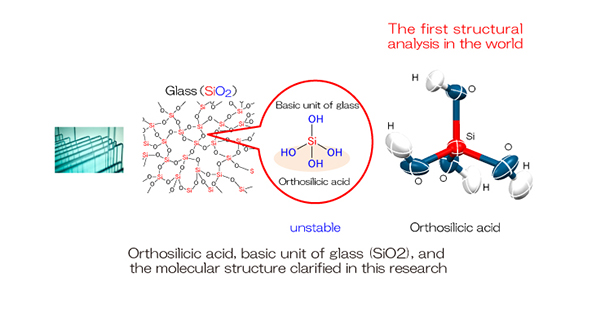
 * Click here to enlarge. * Click here to enlarge. |
| £to Page Top |
| |
|
| FY2017 Meeting to Report on Industrial Use of J-PARC/MLF (July 20-21, Akihabara Convention Hall) |
|---|
| This year's meeting to report on accomplishments through industrial use of MLF was held jointly by the J-PARC Center, Ibaraki Prefecture, Comprehensive Research Organization for Science and Society (CROSS), and the Industrial Users Society for Neutron Application. Many participated from private businesses, universities, research organizations, and more. On the first day, an "accomplishment report" session was held, which included a special seminar and 8 reports (for example, current conditions of industrial applications). At the outset, Toshiji Kanaya, Head of Material and Life Science Division reported on the current conditions at MLF and explained that the facility reached its annual operating rate of more than 90% and is continuing stable operation and increasing the output power to 1MW in the future. In addition, Kanaya introduced 12 research results which were released to the press in 2016, and he announced the effort to yield more results, as well as reforms to promote industrial applications, and more. In the second day session, titled "Innovation co-creation", 3 seminars by the invitees and 8 reports on industrial applications and the facilities were given. The participants actively discussed making the most of MLFfs ability and an arrangement of "results" that MLF and the industries each hope to achieve. |
| |
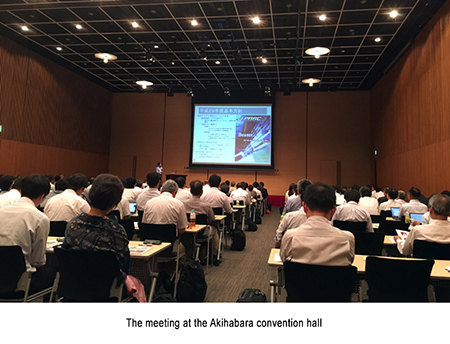
 * Click here to enlarge. * Click here to enlarge. |
| |
| £to Page Top |
| |
|
| 3rd Liaison Meeting on Safety and Health for Contractors of J-PARC (July 7th, Ibaraki Quantum Beam Research Center) |
|---|
| Many contractors are responsible for the management of facility operations, the maintenance of facilities and equipment, and more at J-PARC. Aiming to share safety-consciousness and ensure safety with those contractors, the J-PARC Center has been annually holding a safety and health liaison committee meeting. This year's committee meeting was held on July 7th and had 70 participants from 66 companies. During the committee meeting, Kotaro Bessho, Deputy Head of Safety Division, and Tetsuro Ishii, Deputy Director (Safety), gave reports on accidents, troubles and near misses in recent years, including cases outside of J-PARC. They also discussed safety guidelines at J-PARC, and that it is promoting workers to share and praise good initiatives. Furthermore, as a response to the requests from the contractors, which were to improve climate control of the rooms and protective equipment used during maintenance work, responsible personnel from MLF and the accelerator facility suggested ideas for improvement. |
| |
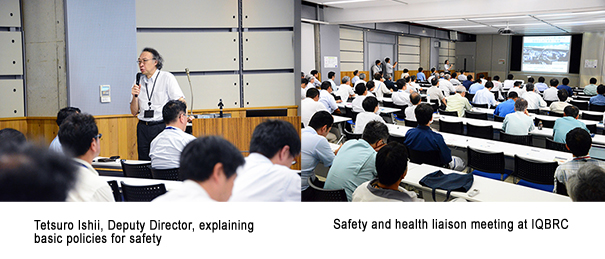
 * Click here to enlarge. * Click here to enlarge. |
| |
| £to Page Top |
| |
|
| J-PARC participated in the Geo Space Adventure (GSA) 2017 exhibit (July 15-16, Kamioka town, Hida city, in Gifu) |
|---|
| The T2K experiment, in progress at J-PARC, shoots out neutrinos, artificially made in the accelerator at J-PARC in Tokai-village, to Super-Kamiokande (SK) at the Institute for Cosmic Ray Research of University of Tokyo, which is located in Kamioka town, Hida city in Gifu prefecture. Changes in flight of the neutrinos have been observed. An exploration event, "GSA (Geo Space Adventure)", has been held every summer in Kamioka town, where SK is located, and its main event is a tour of the SK experimental area inside the Kamioka mine, 1000 m below ground level. For the first time, the J-PARC Center joined this event this year. J-PARC's public relations'staff gave an overview of J-PARC and explained about artificial generation of neutrinos. In addition, a science experiment on the theme of magnets was presented for the audience to learn about the principle of an accelerator. Hida city is planning a tour in August, which will invite people to an open facility at J-PARC. Many Hida city residents are expected to join the tour. |
| |
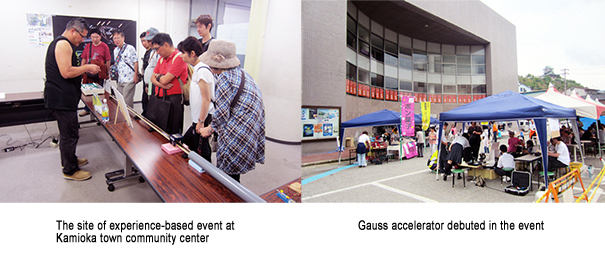
 * Click here to enlarge. * Click here to enlarge. |
| |
| £to Page Top |
| |
|
| 6th J-PARC Hello Science "Naminaminaranu wave power (extraordinary power of waves) -from water waves to particle physics and to the universe-" (June 30, Tokai-village Industry and Information Plaza "iVil") |
|---|
| This was our 6th science cafe, "J-PARC Hello Science", which aims for J-PARC to meet with the locals. The theme we picked this time was "waves", and the event was held at the Tokai-village Industry and Information Plaza "iVil". From sound waves, electric waves, and ocean waves in our everyday life to neutrino oscillation and gravitational waves that spread around in space, Shinichi Sakamoto from the Public Relations Section gave a talk on the scientific theme of waves, including experiments and quizzes. Among other things, during his talk about neutrino oscillation*, participants noticeably felt the "waves". They listened to an undulating sound, which was created by sounds (waves) made by 2 tuning forks, getting louder or quieter. Also, the undulating sound was converted into electric signals, so that the participants were able to see the oscillation on an oscilloscope. The next J-PARC 'Hello Science' Science Cafe will be held on July 28th. "A story of a superconductivity: an advanced technology supporting huge scientific experiments" will be the theme. |
| ∗There are 3 types of neutrinos: electron neutrinos, muon neutrinos, and tau neutrinos. Each neutrino has 2 wave components, and their frequencies are slightly different from one another. Those waves sometimes amplify or cancel each other over time. The difference makes the 3 types of neutrinos, and the phenomenon is known as neutrino oscillation. |
| |

 * Click here to enlarge. * Click here to enlarge. |
| |
| £to Page Top |
| |
|
| J-PARC Hello Science/Scientific experiment class in Tokai-village Shirakata Elementary School (July 6th, Tokai-village) |
|---|
| From time to time, J-PARC holds the J-PARC Hello Science/Scientific experiment class at elementary schools in Tokai-village. This month, Tatsuya Uzumaki from the Public Relations Section visited Shirakata Elementary School's science club and gave a lecture on the theme of "light", demonstrated an experiment, and gave a crafting class. For the experiment to learn about the three primary colors of light, students were marveling in surprise when they saw 3 colors of glowing water (red, blue and green), turn white after they were mixed together. They also made a "kaleidoscope of light". With a pin, they made holes along the picture they drew and looked through the holes at different light sources using a spectral sheet. Students observed how it looked different with natural light and fluorescent light, deepening their knowledge about light even more. |
| |
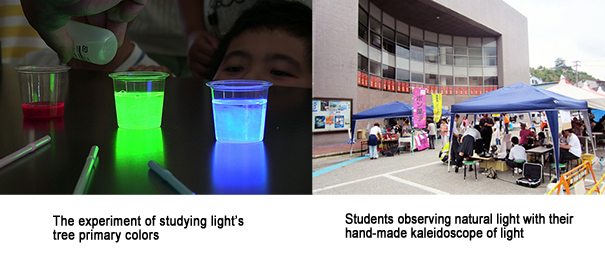
 * Click here to enlarge. * Click here to enlarge. |
| |
| £to Page Top |
| |
|
©2017 J-PARC Center. All rights reserved.
|
|